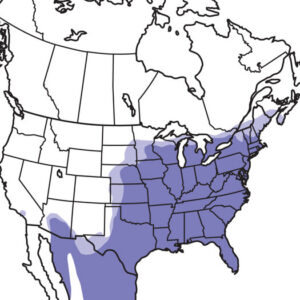 The Northern Cardinal gets top honors among state birds, representing seven states total: Illinois, Indiana, Kentucky, North Carolina, Ohio, Virginia and West Virginia! If you are looking to learn some fun facts about this bird, you’ve come to the right place!
The Northern Cardinal gets top honors among state birds, representing seven states total: Illinois, Indiana, Kentucky, North Carolina, Ohio, Virginia and West Virginia! If you are looking to learn some fun facts about this bird, you’ve come to the right place!
One of the eastern U.S.’s most popular birds, the cardinal is abundant in the Southeast and has been extending its range northward for decades, and it now brightens winter days with its color and its whistled song as far north as southeastern Canada. Feeders stocked with sunflower seeds may have aided its northward spread. West of the Great Plains, the Cardinal is mostly absent, but it is locally common in the desert Southwest.
Feeding Behavior
Forages mostly while hopping on ground or in low bushes, sometimes higher in trees. Readily comes to bird feeders, where it favors sunflower seeds.
Eggs
3-4, sometimes 2-5. Whitish to pale bluish or greenish white, marked with brown, purple, and gray. Incubation is almost always by female alone, 12-13 days.
Young
Both parents feed nestlings. Young leave nest about 9-11 days after hatching. Male may feed fledglings while female begins next nesting attempt. 2-3 broods per year, rarely 4.
Diet
Mostly seeds, insects, berries. Diet is quite varied. Feeds on many insects, including beetles, true bugs, grasshoppers, caterpillars, ants, flies, and many others, also spiders, centipedes, and snails. Most of diet is vegetable matter, including seeds of weeds and grasses, waste grain, leaf buds, flowers, and many berries and wild fruits. Young are fed mostly insects.
 Nesting
Nesting
Male sings to defend nesting territory, actively attacking intruding males (and attacking his own reflection in windows and mirrors). In courtship, male and female raise heads high, sway back and forth while singing softly; male often feeds female early in breeding season. Female sings mainly in spring before start of nesting. Nest: Usually well hidden in dense shrubs, vines, or low trees, placed 3-10′ above ground, sometimes higher. Nest (built by female) is open cup made of twigs, weeds, grass, bark strips, leaves, rootlets, lined with fine grass or hair.
Cool Facts:
- Only a few female North American songbirds sing, but the female Northern Cardinal does, and often while sitting on the nest. This may give the male information about when to bring food to the nest. A mated pair shares song phrases, but the female may sing a longer and slightly more complex song than the male.
- Many people are perplexed each spring by the sight of a cardinal attacking its reflection in a window, car mirror, or shiny bumper. Both males and females do this, and most often in spring and early summer when they are obsessed with defending their territory against any intruders. Birds may spend hours fighting these intruders without giving up. A few weeks later, as levels of aggressive hormones subside, these attacks should end (though one female kept up this behavior every day or so for six months without stopping).
- The male cardinal fiercely defends its breeding territory from other males. When a male sees its reflection in glass surfaces, it frequently will spend hours fighting the imaginary intruder.
- A perennial favorite among people, the Northern Cardinal is the state bird of seven states.
- The oldest recorded Northern Cardinal was a female, and was 15 years, 9 months old when she was found in Pennsylvania.
Want to create a beautiful project on the Northern Cardinal? Check out these State Bird Projects…
________________________
Learn more about My Teaching Library!
BE the FIRST to know about NEW Products by joining the…
My Teaching Library FB group
Posts are made in this group first!!

